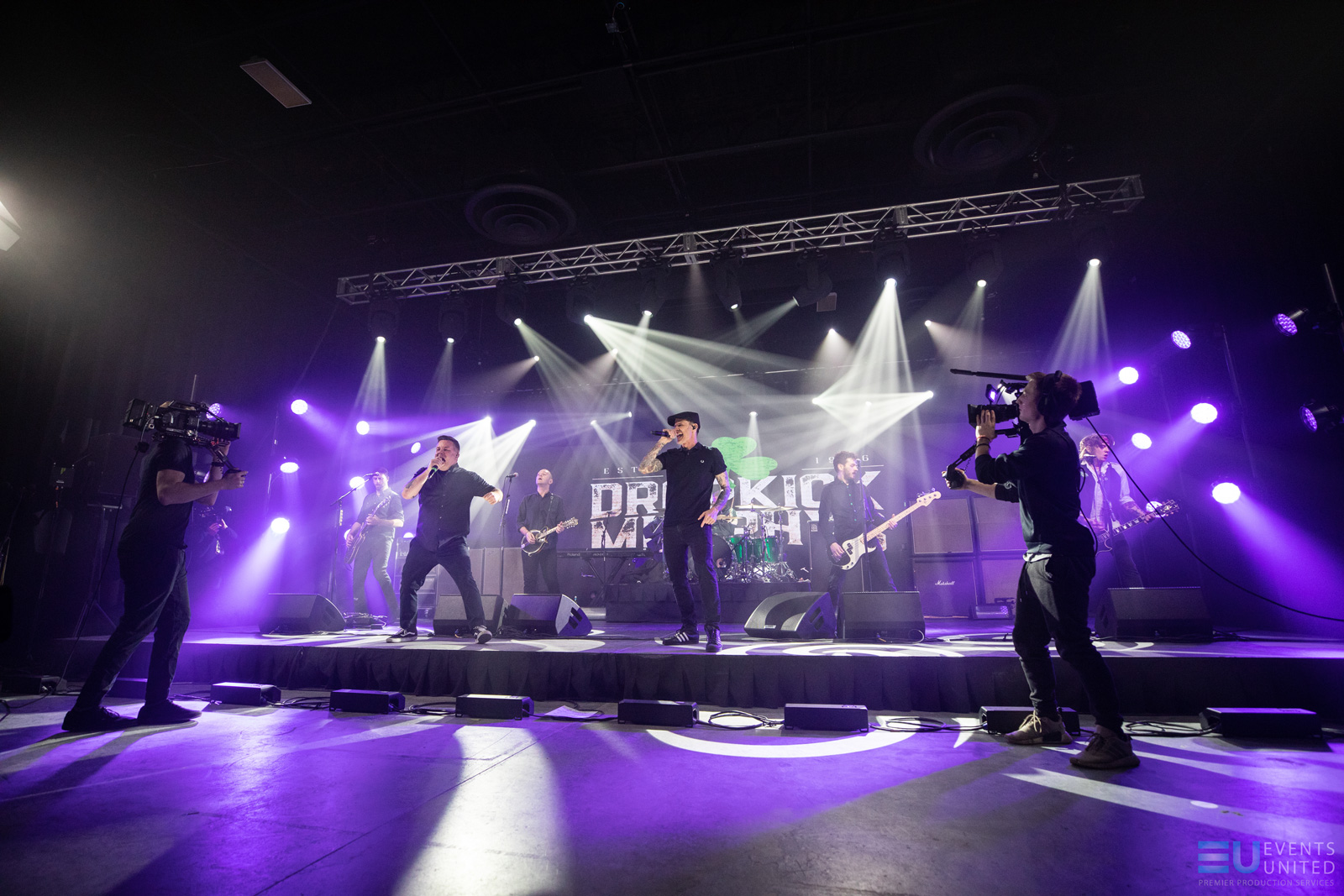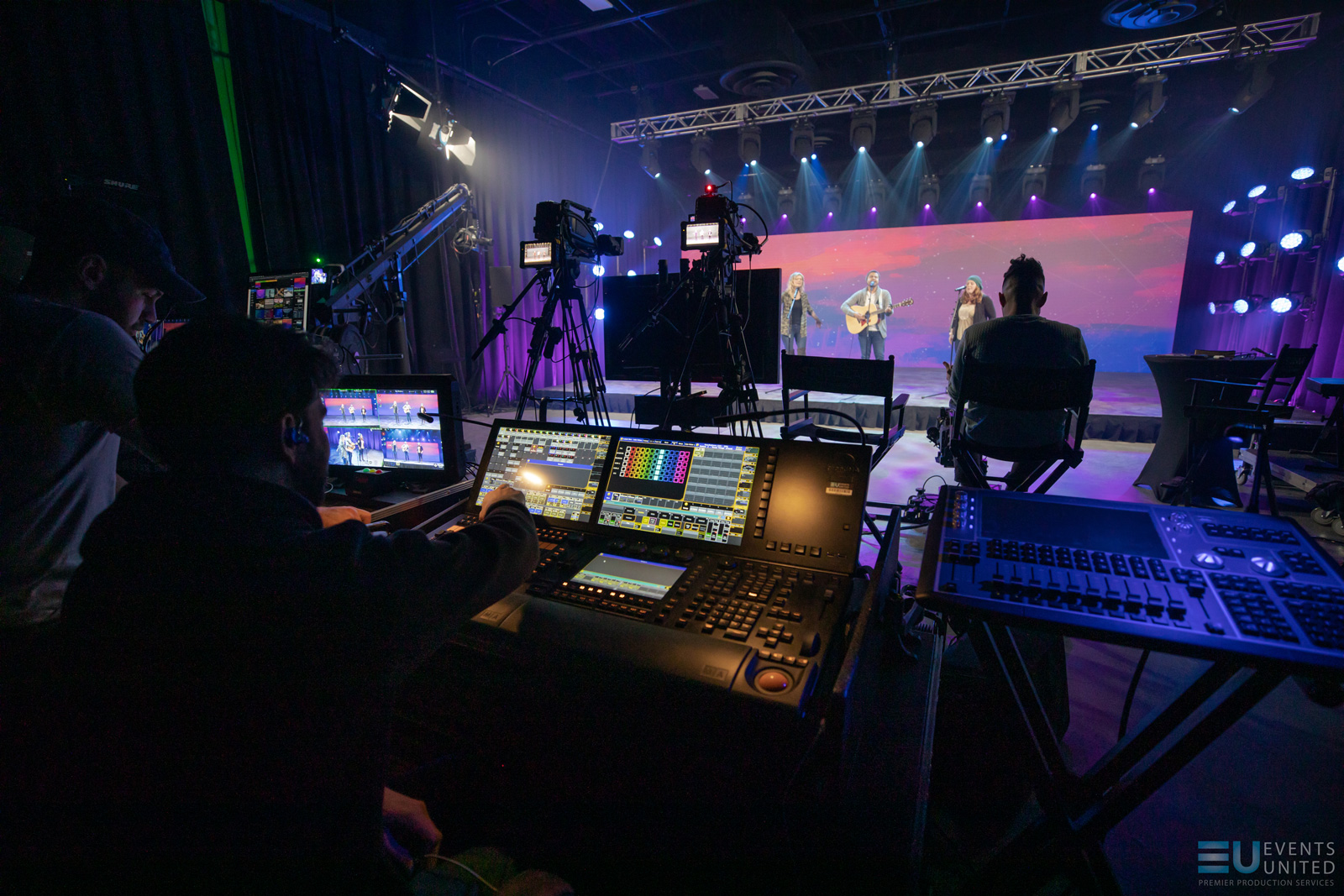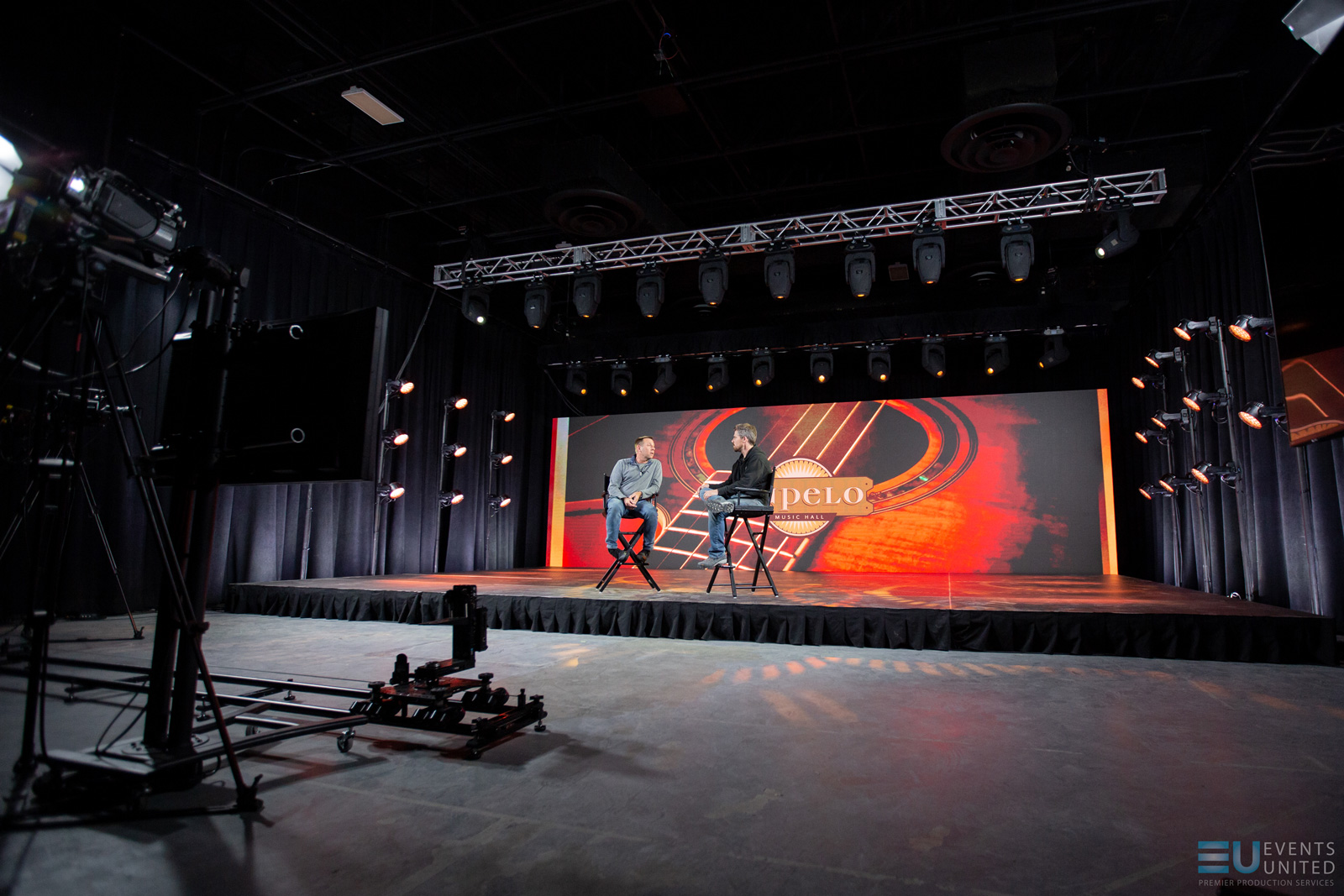Tim Messina – Determined Light
Posted on April 1, 2020
Photo: Lauren Thomason
John Kennedy liked to tell people that when written in Chinese, the word ‘crisis’ was composed of two characters, one representing danger, the other opportunity. Today, this fellow New Englander is demonstrating the wisdom of the late president’s words in the way he has been responding to the coronavirus’ impact on business at his Derry, New Hampshire-based Events United.
With public gatherings prohibited and business dwindling to a trickle, Messina has actively sought new opportunities. Some, like the widely publicized livestream St. Patrick’s Day show by Dropkick Murphys, which was seen by an estimated 40 million people, were high profile. Others like the multiple weekly house of worship services and virtual corporate events his team produces at his studio are less widely known.
Although none of these have come close to replacing the revenue lost by the cancelation of events, they have brought in enough income to keep at least some of his employees working. They have also done something of far-reaching importance by exposing the Events United team to new ideas that are likely to shape business for many years to come. New opportunities are springing forth in the midst of this crisis, believes Messina. Seizing them, will pay dividends long after this moment in time has passed.

Photo: Lauren Thomason
Messina spoke to us about those opportunities as well as the steps he is taking to deal with the current crisis. Among the latter is a conference he organized between representatives of the event industry and government officials. The conference made him more optimistic about the future. His determined attitude leaves us feeling the same way.
You’ve been very proactive throughout this crisis, pushing a lot of ideas in an effort to blunt at least some of the impact coronavirus is having on this industry. How do you maintain this positive attitude?
“I’m not going to kid you; I’ve been stressed and it’s been tough. But even when things are tough, life goes on and you have to go on with it, and while we’re on this ride, we should make the most of every minute. My motivation stems from the same reason I get up and go to work every day: I love what I do and I love the people I work with. The way I look at it, you spend a third of your life working, so you should be passionate about the work and the people. This is what’s driving me. Sure, I’m stressed out of my mind about laying people off and the future of our business, but I want to see this through and be here in good shape once this crisis ends. As painful as this all is, it’s also a very exciting challenge. You have to look for new ways of doing things, new opportunities. Some of the things we are doing today in crisis mode will become standard practices in the live event industry long after this situation has passed. Some innovations will fade away and some are going to impact the future of live entertainment.”
Any examples of those permanent changes?
“We are going to be innovating as hard as we can. Maybe 80-percent of what we do won’t last, but 20-percent will remain in the long term. One lasting change that will come out of this period involves streaming. I don’t think livestreams will ever be looked at the same way. Sure, we’ve had livestreaming for some time, nothing new there, but I think what’s going to happen as a result of current events is that you’re going to see more opportunities for people to interact with livestreamed events.”
“People online will be able to interact more with livestreamed shows so their experience is unique, it’s different than going to a live show and it’s different than watching a video of your favorite band on Netflix. The current situation has taught us as an industry to be less dependent on exclusively-live events. We can do this by making streaming a more important part of the whole package.”

Photo: Lauren Thomason
Speaking of livestreaming, the Dropkick Murphys St. Patrick’s Day show received a lot of attention, garnering over 10 million views. Can you tell us how that came about?
“Actually, a friend of mine from NBC told me that we hadn’t yet considered an averaged multiplier, which is how TV stations count overall views. There were over 10 million views that the streaming platforms counted, but that doesn’t consider the fact that most people in the US were celebrating St. Patrick’s Day with family and friends. Say on average there were four people viewing on one device, then we can assume that there were actually more like 40 million views.
“This all started when our friends at Ultrasound, LLC hired us to provide the audio control package for the Dropkick Murphys’ northeast tour. The band and crew rehearsed in our studio for two days and then we prepped the gear to head out on tour. We were about to push the gear on the truck when we heard the tour was cancelled. When this happened, the band decided to stream their St. Patrick’s show. At that time, we had no video gear set up in our studio since the band had just been rehearsing in there. Then, almost overnight, we built a virtual event stage in our studio.”
So how did the actual livestream show come off?
“There were some nervous moments! It was 6:55 pm and the show was scheduled to start at 7. We started the bumper videos, and immediately 80,000 people were watching on Facebook and another 80,000 on YouTube, and the show hadn’t even started yet! Then, the stomach wrenching starts…the audio started stuttering and comments came pouring in saying that there was a problem. Time to freak out! But luckily my team is amazing and quickly worked out the issue and the show started without a hitch. There were 25 people from my team involved, plus we had the awesome Dropkick crew joining us. It was very much a team effort. Jon Martell did a great job as video manager. My friend Andre Martinez, who is the Director of Photography for The Bachelor, was available to run one camera, as was my nephew Ian Messina and our friend Greg Farnum, who are excellent on camera. The rest of our video team included Trifon Athnos, who ran our automated camera, Joel Pelletier, Dustin Davis, Kent Rich and Marc Therrien.”

Photo: Lauren Thomason
Was it challenging to do a show without an audience?
“Brian Lareau, the lighting designer, did a great job keeping full production looks throughout the show. Our stage was 32’ by 20’ with a 10’ high video wall backdrop. We didn’t try to hide that there was no audience; it was made part of our overall look.
“Interestingly, Ken Casey from Dropkick Murphys and I talked about the band playing to an empty room. The band feeds off the energy of the crowd, so there was concern about not having that during this show. Ken asked the crew to be vocal and lively to help energize the room. So, the few of us in the room did just that! We tried to fill in for a 6,000-person crowd, I’d say we did a pretty impressive job.”
How did the livestream work out for Events United from a business standpoint?
“We had to pivot our business so fast from a live events company to a virtual production company, we didn’t even have time to figure out how to price this. Remember, this all happened in two days! At first, we thought this was going to be a four-camera shoot with about ten people to make it happen. As the two days quickly flew by, plans and expectations grew from every angle but the budget was already set. In the end there were 25 people involved from my team to pull this off, and we didn’t even charge enough to even cover labor. It was not a money maker, but it gave us an opportunity to keep some of our people active. Plus, it was a way of exploring new ideas and partner with a band we love to work with. Earlier, I mentioned that some of the changes we’re making will be around for the long-term. I think one of the things we’ll see going forward is that production companies will figure out how to make money on livestreaming, which will give them more funds to devote to production. Right now, SoundCloud and Twitch are looking at creating a platform that will help artists make money on livestreamed shows. If this happens, I think it will have a big impact on our industry with great opportunities opening up for designers and production houses.”

Photo: Lauren Thomason
Churches have been looking for ways to reach worshippers online, now that they can’t have services on their campuses. How has this influenced your business?
“We have several churches who are coming to our studio during the week to use video services. We provide them with a turnkey solution that includes audio recording, lighting looks for the pastor and band, a video backdrop, and video recording. Plus, we hand them the recorded service and tell them how to stream it on Sunday if they need help. We try not to do livestreaming of Sunday services at our studio, because it adds a lot of pressure to a church who has never done it, and we like to give our crew the weekend off if possible. With churches, we typically have the pastor and three or so band members come to our studio. We limit them to no more than six band members per visit as a health precaution, and because we’re trying to be efficient with their time. More band members means more monitor mixes which means more time.”
Are the church videos generating revenue?
“Again, it’s basically paying for our time. We finally just made a pricing structure that works within most churches’ budgets. It could be profitable if we have enough churches and we become incredibly efficient with our time. The problem is the amount of gear we put in the studio is significant. We wanted each video to look and sound great and that took a fair amount of gear to pull off. So with this said, none of us have been through anything like this before. We explain this to churches and ask them to pay what they can afford as long as it’s fair. Thus far, it’s worked out enough to help us keep our people busy, which is the name of the game today, given what our industry is experiencing.”
On that subject, you recently organized a teleconference meeting between event industry representatives and government officials to discuss the impact that the coronavirus pandemic is having on this business. Can you tell us about that?
“We had 40 different business owners, mostly production companies, but also some event planners and venue owners, as well as state officials from New Hampshire and Massachusetts and our US Congressional Representative, Chris Pappas. We covered a range of topics, such as how to help our employees that we had to or are going to lay off — and to see if there are ways that the government can make up the financial difference for employees who stay on with reduced pay and hours. Things like the suspension of rent and taxes were also covered. The government people were very aware of the impact that all of this is having on the event industry. I can’t say that anything concrete resulted, but everyone walked away with valuable information on how to move forward. Also, among the members of our industry who were present, there was a definite sense that now is the time to see ourselves as partners, not competitors.”

Photo: Lauren Thomason
Can you elaborate on that last point?
“Perhaps the biggest benefit that those of us at that meeting got out of it was the realization that we are not alone. None of us have ever been hit by anything like this before, so it helps to share our experience. The idea for this meeting came to me from a humorous Facebook post by Daniel Bouchard of AE Event Systems who posted the idea of having a WTF summit for event professionals. I got in touch with him and suggested doing a serious meeting. It helped all of us, and I recommend that other people in our industry do it on a regional basis.”
Where do you see things going from here?
“We will get through this. There’s a lot of unknowns right now but we are trying to keep key people on. We’ve had to lay off people we really care about, but our challenge at this moment is to keep the company afloat, so there’s a company for them to come back to once the live event returns. Once this is over, there will be an explosive demand for event production. We’re eagerly waiting for that time; however, this will create a new issue. There is a high probability that many events that were postponed will be booking on the same day as many other events which will create a shortage of gear and labor. We won’t be in a financial position to purchase more equipment, and even if we were, it is very likely that we wouldn’t be able to keep up. We will need our new allies more than ever to get through that time. Our industry is going to have to come together. If it does, the future should be very exciting, because even though there are a lot of bad things happening now, there are also a tremendous number of new opportunities that will come out of this crisis. How we take advantage of them is going to define our future.”

Photo: Lauren Thomason